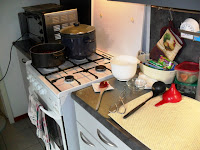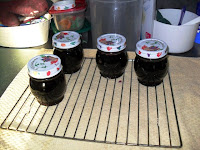Sometimes, during the summer and fall when fruit is available, you just don't have the time to make your jellies and jams. That is no big problem really; you can start the process and finish it later.
Last summer I picked far more elderberries than I needed for jelly last winter so I processed the berries to the juice stage and stored the juice in my freezer until it was needed. I just used several plastic juice bottles and measured out one batch of juice (3 and 3/4 cups juice for my recipe). Of course, make sure you thoroughly clean the plastic container and leave space in the bottle for the expansion of the juice when it freezes. I took the juice out of the freezer on Monday so it could thaw slowly in the refridge until Saturday when I made jelly.
There are lots of books on jelly making and of course thousands of sites on the internet so I won't go into too much detail on the recipes or cooking process; it will be slightly different for each fruit and recipe. The important thing is to read the recipe and directions several times so it is well in your head before you start. Then, get out all the pots and pans, measuring cups, ingredients, etc. before you begin. I like to walk through the process one time, without using the ingredients, just to make sure I have enough space and the things I need are at hand.
Jelly making is more of a science than an art. You must follow the directions exactly or the jelly might not set properly. Substitutions rarely work so buy what you need and have it available. Each type of Pectin is different and they cannot be substituted. Pectin is the ingredient that "sets" or jells the jelly. My family has always used "Sure-Gel" but I am not advertising for them.
Your jars and lids must be sterile and and I prefer them to be hot to the touch when I pour in the jelly mix. This prevents the glass from cracking, which can happen if you pour boiling jelly into a cold glass jar. The large pot on the back of my stove has the jars and lids cooking in boiling water. The lids are sitting in a perforated pan inside the pot so they are out of the water but being steamed. This just makes it easier to grab a bottle and a lid when the time comes. All my other tools and equipment are set out and ready to be used.
When jelly cooks a certain amount of impurities will float to the surface and form a foam; this is natural. Follow the recipe's cooking instructions and if you want to use the foam (it is delicious) wait until the jelly is ready to be poured into jars before skimming off the foam. This way it will also set into jelly. You can clearly see the foam in this picture.
I use a large spoon or small ladle to skim the foam off the top of the liquid jelly mix. I spoon it over into a small bowl to save. It will separate in the bowl and the foam will sit on top of the jelly. It is up to you if you want to eat this or throw it away. My family always ate the foam and it has a very strong flavor.
Once the cooking jelly is ready (according to your cooking directions) you can pour or ladle it into the hot jars. If two people are available have one pour and one put on the lids. You only need to hand tighten the lids, they don't have to be forced. There is a rubber gasket glued inside the lid and it does the sealing. Normally you only use the lids once but you can use the jars forever as long as the rim stays smooth. If the rim gets chipped then the jar is no good. I have successfully reused lids, necessary where I live because they don't sell replacement lids here in The Netherlands. Out of these four jars one lid did not seal properly so I'll use that jar first. If you don't want to buy canning jars, lids and rings, you can use any recycled jars and seal them with paraffin wax (Gulf Wax is the brand we used). This adds a step (melting and pour wax into each jar) but works just fine.
It takes just about the same amount of time to make eight jars of jelly as it does four so consider making your jelly in larger batches. When I was growing up my family made hundreds of jars of jelly every year so doing big batches was more normal. I only have six jars so I do small batches and time is not an issue for me.
I had Elderberry jelly foam on my toast this morning for breakfast; what a nice treat.
Making your own jelly can be cheaper than buying it if you can get the fruit for free (foraging) or very cheap. If you are going to make a lot of jelly you should buy your Pectin in bulk online (or at a store if one sells it). Go to this URL to read a discussion about pectin: http://forums.gardenweb.com/forums/load/harvest/msg0510165820597.html
Sugar is the other expensive ingredient so buy it on sale with coupons and store it; sugar keeps a long time if kept cool and dry.





No comments:
Post a Comment